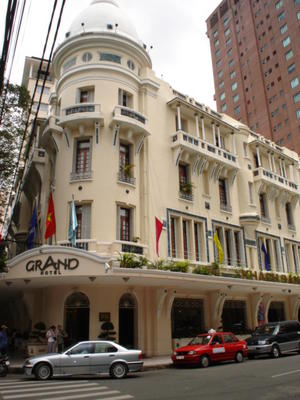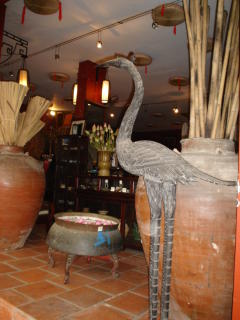
After two weeks here, mostly driving to and from work, I thought I had a pretty good idea of what the city looked like, and I liked it: a foreign country, a new culture, lots of noise and lots of traffic. Somehow, I didn’t expect to find a ritzy, western-style-shops area. Today I went there.
It took two days of checking two guide books and three different maps, but I thought I had finally figured out where to ask the taxi to take me to get to the tourist shopping area. (my sense of direction, even with three maps, sucks big-time.)
Carefully, I jotted down the appropriate intersection – Le Loi and Dong Khoi. Again, back to the maps to try and get the proper accent marks, which was hard because those little marks get even littler on a map. Over some letters, I just scribbled and hoped the taxi driver would think it was bad handwriting, not the wrong mark.
Once in the taxi, I showed the driver my piece of paper, and tried to pronounce the streets. We sat for a few seconds, while he carefully enunciated each syllable and he wouldn’t take off until he was sure I had the sounds close enough. We kept practicing as we drove.
At one stop light, he pulled out a piece of paper and wrote ‘thirty’.
“Excuse me,” he said, “how do you speak this?” Then we practiced English for the next kilometer. I wanted to keep up the conversation, to ask why he needed to know the pronunciation of ‘thirty’, but it couldn’t be done.
“I like speak English”, he said.
The traffic’s insane! I said. We smiled and laughed.
At my stop, he again pulled out the paper and drew an intersection. I understood that he wanted to know what you call it. I wrote down ‘this is the intersection of Le Loi and Dong Khoi’. He corrected my pronunciation of the streets, I corrected his saying of ‘intersection’. I paid, we smiled, said good-bye.
As I got out and looked around me, I knew I was in a different city. Wide streets, fancy gardens, expensive boutiques, 5-star hotels. And something very different: tourists. The parts of town I have been in really don’t have them. When I walk around my house, or at the schools, I am very aware of how different I look. But down here, the foreigners were everywhere.
I had my maps, but am well aware of what happens when I try to read one; I just can’t tell left from right. It is usually better if I simply start walking, and when I get tired, hail a taxi for home. I check out the map once I have returned to the known realm of my room.
So I sauntered around the district, looked into the stores, but didn’t go in. I am going to be here a long time, and the last thing I need to do is start buying souvenirs. Anyway, I figured this part of town had to be way expensive.

Then I passed a store where the whole front wall was an open entry-way. You could easily see the handicrafts, and silk scarves, and smell the incense burning. I supposed it was ok to just go in and look. Hanging paper lanterns kept the lighting low, as I squeezed in around display tables and cases filled with wonderful things. Baskets and silk pillow cases and beaded jewelry and ethnic clothing and old photographs and tons of other stuff I only got a glimpse of. I was surprised that the prices were so reasonable, if not down-right cheap. However, I wasn’t here to buy, so didn’t I didn’t really take my time looking at things. I was merely enjoying the atmosphere and the fragrant air.
Out of the corner of my eye, I noticed this fabric and beaded necklace type thing that I assumed was from an indigenous tribe. I touched it. I turned it over to see the price: US$8. I removed my hand. I looked at it again. I took it down. I hung it back up and walked away. Two steps later I walked back. $8??? I could afford that. And past experience has taught me that if you see something you want; buy it, because you will never find it again.
I took it over to the woman at the register. (although it wasn’t a register, of course, it was a table). I asked her about it.
“This comes from the Yao minority group in the north of Viet Nam.” I hesitated again.
How much is it in Vietnamese Dong? She didn’t even need a calculator.
“127,000 Vietnamese Dong.” Yikes! Why did that sound so much? I started to take it back. Wait, maybe I had enough dollars on me. I checked. I had $6.
Can I pay part in dollars and part in Dong? That way it wouldn’t seem so expensive. I handed her the $6 and 30,000 dong.
They wrapped my necklace in beautiful, purple paper, then stuffed it in a little woven, palm leaf bag. I got a card from the store so I could be sure to find it again.
I continued my walk and got completely turned around, as usual. Seems I couldn’t even find where the taxi had left me off. But I did stroll into another shopping area that was not so high-end. But by then, I had been walking for about two hours, it was almost noon and getting a little warm.
As I hailed a taxi, I tired to pinpoint where I was so I could go back tomorrow. It was useless. I was either north or south or left or right of where I had started earlier in the day. Thanks goodness I always carry the address of where I live so I can show it to the taxi driver. I should really try to memorize it for any future emergencies. If I ever lost it, I really would be lost.
Happy Trails,
Kate
